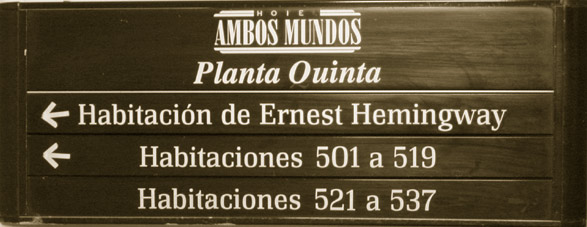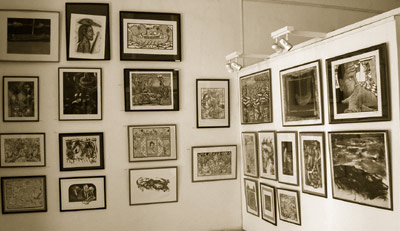|
Casa de Carmen Montilla
Street Oficios e/ Amargura y Churruca, Old Havana
Phone: 833-8768
Casa Fundacion Guayasamin
Street Obrapía No. 112 e/ Oficios y Mercaderes, Old Havana
Phone: 861-3843
Casa de las Americas
Street 3RA & G, Vedado
Phone: 55-27.12
Gallery 23 y 12
Street 12 esq. 23, Vedado, Havana
Phone: 831-3339
Gallery Ciudades del Mundo
Street 25 esq. L, Plaza de la Revolucion, Vedado, Havana
Phone: 832-3175
Gallery Nacional De Bellas Artes
Street Trocadero e/ Zuleta & Monserrate, Old Havana
Phone: 861-02.41
Gallery de Arte Latinoamericano "Haydee Santamaria"
Street G e/ 3ra y 5ta, Vedado, Havana
Phone: 32-4653
Gallery Forma
Street Obispo No. 255 e/ Cuba y Aguiar, Old Havana
Phone: 862-2103
Gallery Habana
Street Linea No. 460 at corner E & F streets, Vedado, Havana
Phone: 832-71.01 or 831-46.46
Gallery Horacio Ruiz
Street Tacon No. 4 , Old Havana
Gallery "La Acacia"
Street San Jose No. 114 e/ Industria y Consulado, Havana Center
Phone: 861-3533 & 863-9364
Gallery "La Casona"
Street Muralla No. 107 at corner of San Ignacio, Old Havana
Phone: 862-2633 & 862-2377
Gallery Mariano Rodriguez
Street 15 No. 607 e/ B y C, Plaza de la Revolucion, Vedado, Havana
Gallery Victor Manuel
Street San Ignacio No. 56, Plaza de la Catedral, Old Havana
Phone: 861-2955
Gallery Taller de Serigrafia Rene Portocarrero
Street Cuba No. 513 e/ Teniente Rey y Muralla, Old Havana

Museum of Ernest Hemingway
Address: Street Obispo & Mercaderes, Ambos Mundos hotel, Old Havana. Open: Monday to Saturday.
Hotel Ambos Mundos is famous because of the writer Ernest Hemingway, Literature Nobel Prizewinner, stayed in room 511 during a relatively lengthy period of 1932 to 1939. It was precisely in that room where the great novelist wrote some chapters of one of his most famous novel, "For Whom the Bell Tolls", as well as several articles published in the "Esquire" magazine, among other works, before moving out to La Vigia estate, in the southeastern end of Havana.
Hemingway himself referred to Ambos Mundos as a "good place to write", in allusion to the attractive atmosphere of the hotel, characterized by an eclectic architectural style.
Tourists can visit room 511, a mini museum with some of Ernest Hemingway belongings still scattered around his room where the famous novelist stayed, surrounded by a strong emotional atmosphere reminiscent of the old days.
National Museums of Fine Arts
Address: Street Trocadero e/ Zulueta y Monserrate, Old Havana. Open: Tuesday to Sunday
Its construction was completed in 1953, three years later it received the collections of the then National Museum. It was built on the site of the former Mercado del Polvorin. Architect Alfonso Rodríguez Pichardo designed a very modern building for the time. It was the final solution to provide a permanent seat to the National Museum , which bad been created by decree in 1913, but was wandering from one place to another in the city without government support. The Palace of Fine Arts houses the largest collection of Cuban plastic art. There is a hall dedicated to the Cuban painting and gravure from the 16th century up to now. Arabian House Museum
Address: Street Oficlos e/ Obispo y Obrapia, Old Havana. Open: Tuesday to Saturday.
The old colonial home that houses The Arabian House, is located in heart of Old Havana, is itself a great example of the strong Moorish influence on Cuban architecture since the 18th century.
The red-brick arcade, the form of the ceilings and galleries, and the ample inner patio decked with plants and flowers epitomize the Mudejar construction style brought over to Cuba by Spanish master builders. The halls boast marquetry pieces with ivory and precious wood inlays; practical and sumptuous robes worn by Saharan nomads; remarkable camel saddles; exquisite rugs and tapestries, and an exact replica of an Arab market place.
Also on display is one of Nature's wonders: a desert rose, a calcareous formation resembling a flower that occurs on sandy soils when evaporation causes salts to concentrate. Eighteenth and nineteenth century weapons, gold and silver plated and with intricate ornaments, form one of the most complete collections in the country.
There are also Islamic weapons from the 18th-19th centuries. They are plated with gold and silver, carefully decorated, and form one of the most complete collections in the country. It is the only place where there is a room for Muslim prayers, and it is open to national and foreign believers, with a collection of the Koran and other cult objects.
It also has a specialized restaurant in Arabian cuisine.
National Museum of Decorative Arts
Address: Street 17 No.502 e/D y E, Vedado. Plaza de la Revolucion, Havana. Open: Tuesday to Saturday.
It houses permanent and temporary exhibitions of the most coloured samples of European and Asian applied arts, ceramics, chinawares, furnitures, paintings and sculptures of the 19th and 20th century. Applied arts. Ceramic. Porcelain. Ancient furnitures. Paintings. Sculptures.
Napoleon Museum
Address: Street San Miguel No. 1159 esq. a Ronda Vedado, Havana. Open: Monday to Saturday.
It is one of the most important museums of its kind around the world. It is located next to the University of Havana, in a Florentine-style palace, which amasses objects used by Napoleon Bonaparte in different stages of his life: the guns that Bonaparte was carrying in the battle of Borodino, Bicorne and telescope used in Santa Elena, Different objects of the time that marks the end of the Bourbon monarchy, Samples of historical periods known as the Governing Body and Consulate, Different pieces of the end of the First Empire, personal belongings of Napoleon
Bonaparte
I.
Artistic Ceramic Museum
Address: Street O´Relly No. 2 y Ave. del Puerto, Old Havana. Open: Monday to Saturday.
Located at the Castle of the Royal Force, "Castillo de la Real Fuerza". There are works by artists such as Amelia Pelaez, Wilfredo Lam, Rene Portocarrero, Rodriguez de la Cruz, and various representatives of the new generations of Cuban ceramists.
Museum of Colonial Art
Address: Street San Ignacio No. 61 e/ Empedrado y O'Reilly, Plaza de la Catedral. Old Havana.
Open: Every day
It is the former house of Count Casa Bayona, built by 1720 and privileged located across from the Cathedral of Havana. It is also considered to be the first residence that was built with a stately style of the 18th century in such square.
The house distinguishes itself from the surrounding buildings in the Cathedral Square for the absence of arcades. Its great facades show the Cuban colonial architecture. lts ceilings resemble a Spanish mudejar decoration. Luis Chacón lived in it when, he was part of the island's government, at the beginning of the l8th century. It was a house until the end of the l9th century; then, the headquarters of the College of Actuaries and, afterwards, the news room and printing shop of the ôLa Discusion newspaper. In 1935, the Arrechabala rum company installed its warehouses and offices here, as well as a private bar that was very busy in those days. Once restored, the Museum of Colonial Arts was installed in it in 1969.
In the rooms of the museum there is an important representation of the decoration and furniture of the biggest colonial mansions of Havana from the l7th to the 19th centuries. Furniture. Glassware. Porcelain. Grille. Doors. Carriage. Stained glass windows and fornalete, art style that was especially developed during the colonization.
National Museum of Music
Address: Street Capdevila No. 1 e/ Aguiar y Habana, Old Havana. Open: Tuesday to Saturday
Built in 1905 for merchant Francisco Pons, the house became the residence of me Perez de la Riva family up to 1936. In that year it was acquired by the Cuban government to install the Secretary of State. In 1981 it was restored to settle down the Music National Museum .
Its collections store folk instruments, scores of fundamental pieces of our country, music machines, etc. The facade is of stalls, imitating the Italian Renaissance. Their interiors were eclectic in styles, but maintaining the sobriety and the elegance characteristic of one of the best Havana residences in principles of the 20th century. It portraits the historical development of the Cuban music and its instruments from the 16th to 20th century. History of the Cuban and international music. Musical instruments.
Museum of Cigar
Address: Street Mercaderes No. 120 e/ Obispo y Obrapia, Old Havana. Open: Tuesday to Saturday.
It dates from the 18th century and is the only building in Cuba that harbors a museum to show the tobacco culture on the island. Its exhibition includes tools for the processing of tobacco leaves pipes, lighters and other items of the art of smoking besides a vast collection, of lithographic stones and rings of prestigious cigar brands. The Museum also has a shop, specialized on Cuban cigars. |

